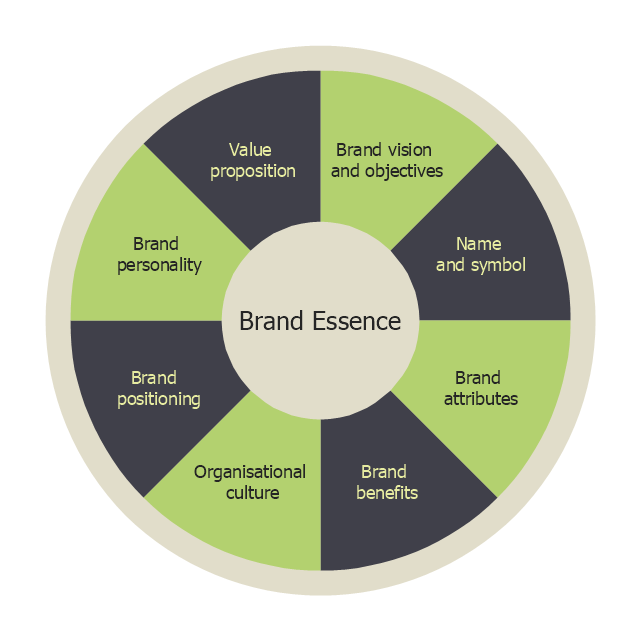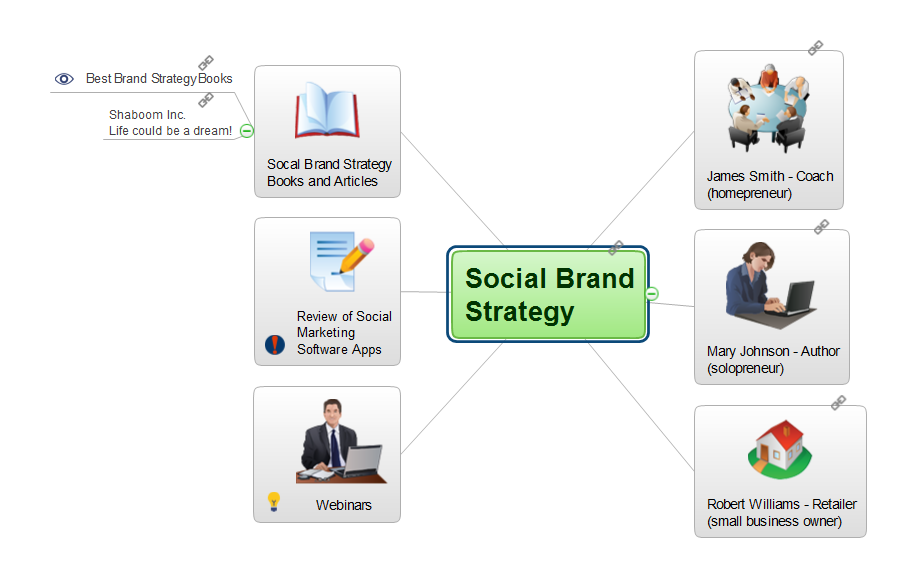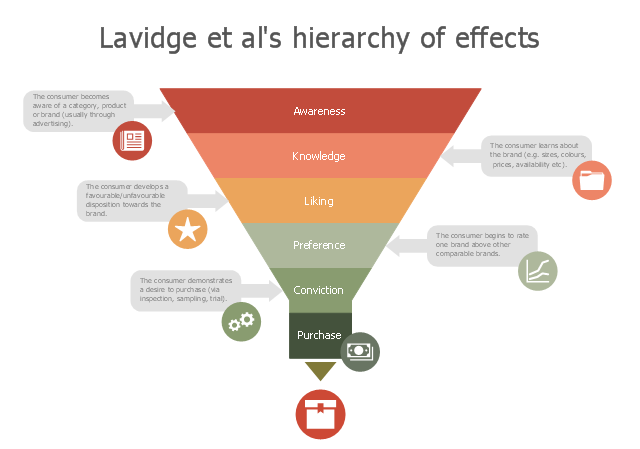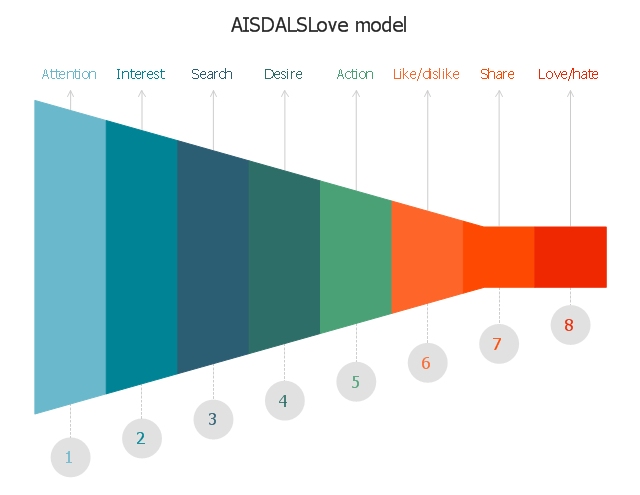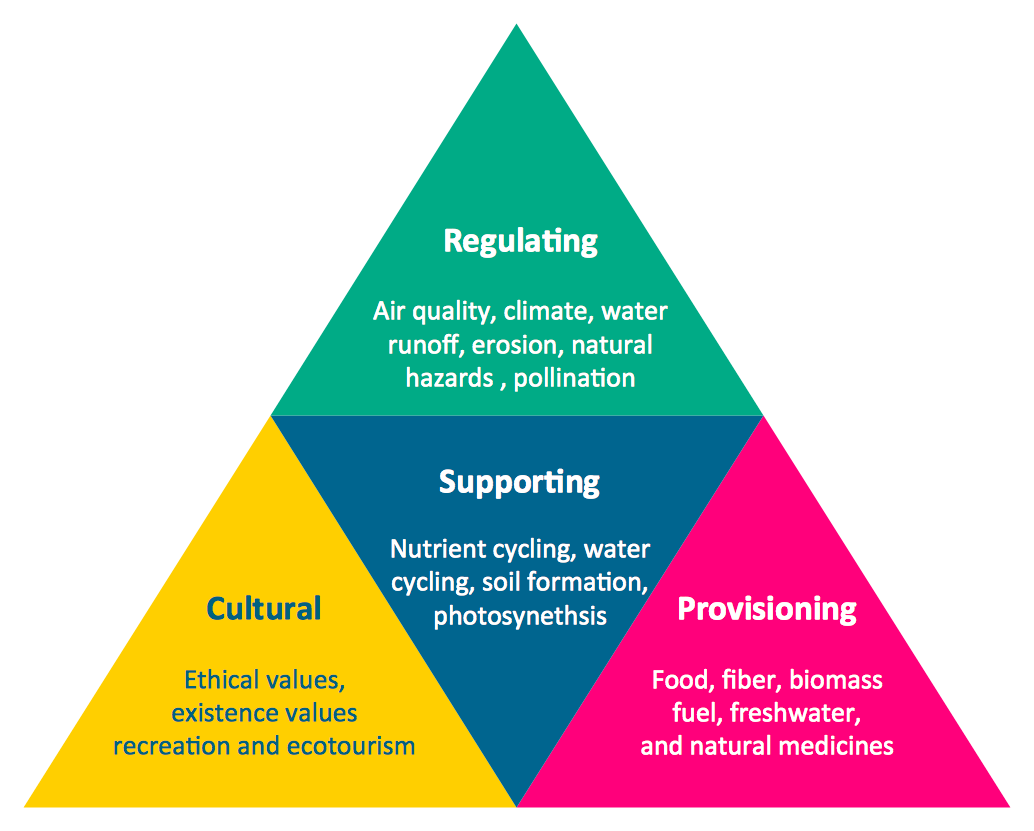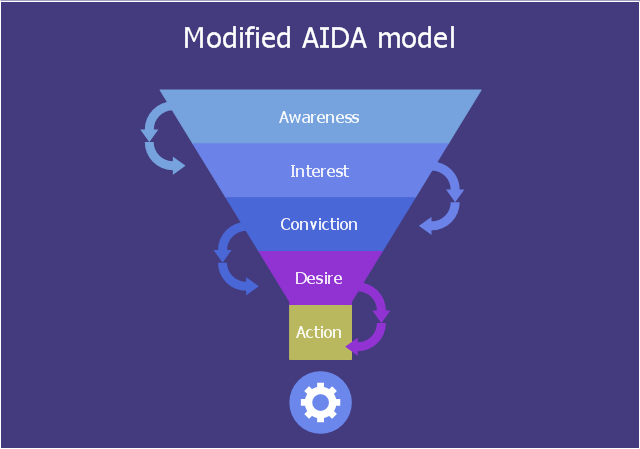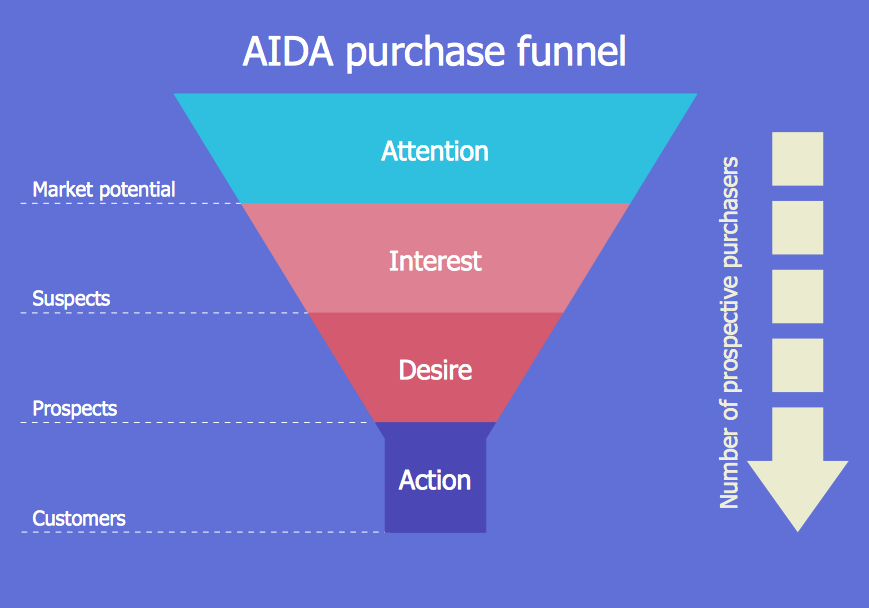"Brand essence is a phrase that communicates the fundamental nature of a trade name associated with one or more products made by the same company. A business marketing team will often spend considerable time developing effective ways of expressing the brand essence of their company's various brands by highlighting the unique benefits provided that pertain to the values of its target subculture." [businessdictionary.com/ definition/ brand-essence.html]
Brand essence model diagram visually display key points of brand essence in easy to understand form.
The example of wheel diagram (ring diagram, bevel style circle diagram) "Brand essence model" was created using the ConceptDraw PRO diagramming and vector drawing software extended with the Target and Circular Diagrams solution from the Marketing area of ConceptDraw Solution Park.
www.conceptdraw.com/ solution-park/ marketing-target-and-circular-diagrams
Brand essence model diagram visually display key points of brand essence in easy to understand form.
The example of wheel diagram (ring diagram, bevel style circle diagram) "Brand essence model" was created using the ConceptDraw PRO diagramming and vector drawing software extended with the Target and Circular Diagrams solution from the Marketing area of ConceptDraw Solution Park.
www.conceptdraw.com/ solution-park/ marketing-target-and-circular-diagrams
Social Brand Strategy
In the mind of consumer the brand is a entire image of a product, which is invariably associated with its specific characteristics. Every manufacturer knows about this fact and in conditions of great competition actively applies the brand management, and strives to create unique and memorable brand for a new product appearing on the market. Brand management is carried out at different levels from the corporate brand, family brand to the individual brand. The brand strategy is a methodological tool of brand management, a long term plan of brand's creation and management, systematic brand development to achieve the goals. Brand strategy is built according to the brand's essence and principles of competition. Effective brand management and development of social brand strategy, its realization, implementation and promotion are important, but quite complex tasks. The main goal of brand strategy is to achieve that the brand become an ideal in the minds of consumers and was easily recognizable by them. The social media provide the great assistance in this and help effectively influence the target audience. A visual Mind Map created in powerful ConceptDraw MINDMAP application organizes the research and methods for the social brand strategy."Brand awareness refers to customers' ability to recall and recognize the brand under different conditions and link to the brand name, logo, jingles and so on to certain associations in memory. It consists of both brand recognition and brand recall. It helps the customers to understand to which product or service category the particular brand belongs and what products and services are sold under the brand name. It also ensures that customers know which of their needs are satisfied by the brand through its products (Keller). Brand awareness is of critical importance since customers will not consider your brand if they are not aware of it. There are various levels of brand awareness that require different levels and combinations of brand recognition and recall. Top-of-Mind is the goal of most companies. Top-of-mind awareness occurs when your brand is what pops into a consumers mind when asked to name brands in a product category." [Brand. Brand awareness. Wikipedia]
This top brand model pyramid diagram was redesigned using the ConceptDraw PRO diagramming and vector drawing software from Wikimedia Commons file Diagram Top Brand Model.jpg. [commons.wikimedia.org/ wiki/ File:Diagram_ Top_ Brand_ Model.jpg]
This file is licensed under the Creative Commons Attribution-Share Alike 3.0 Unported license. [creativecommons.org/ licenses/ by-sa/ 3.0/ deed.en]
The example "Top brand model pyramid diagram" is included in the Pyramid Diagrams solution from the Marketing area of ConceptDraw Solution Park.
This top brand model pyramid diagram was redesigned using the ConceptDraw PRO diagramming and vector drawing software from Wikimedia Commons file Diagram Top Brand Model.jpg. [commons.wikimedia.org/ wiki/ File:Diagram_ Top_ Brand_ Model.jpg]
This file is licensed under the Creative Commons Attribution-Share Alike 3.0 Unported license. [creativecommons.org/ licenses/ by-sa/ 3.0/ deed.en]
The example "Top brand model pyramid diagram" is included in the Pyramid Diagrams solution from the Marketing area of ConceptDraw Solution Park.
"Branding strategies.
Company name.
Often, especially in the industrial sector, it is just the company's name which is promoted...
Individual branding.
Each brand has a separate name ..., which may compete against other brands from the same company...
Attitude branding and iconic brands.
Attitude branding is the choice to represent a larger feeling, which is not necessarily connected with the product or consumption of the product at all. ...
Iconic brands are defined as having aspects that contribute to consumer's self-expression and personal identity. ...
"No-brand" branding.
Recently a number of companies have successfully pursued "no-brand" strategies by creating packaging that imitates generic brand simplicity.
Derived brands.
In this case the supplier of a key component, used by a number of suppliers of the end-product, may wish to guarantee its own position by promoting that component as a brand in its own right.
Brand extension and brand dilution.
The existing strong brand name can be used as a vehicle for new or modified products ...
Social media brands.
social media brands may be the most evolved version of the brand form, because they focus not on themselves but on their users. ...
Multi-brands.
Alternatively, in a market that is fragmented amongst a number of brands a supplier can choose deliberately to launch totally new brands in apparent competition with its own existing strong brand ...
Private labels.
Private label brands, also called own brands, or store brands have become popular. Where the retailer has a particularly strong identity this "own brand" may be able to compete against even the strongest brand leaders ...
Individual and organizational brands.
There are kinds of branding that treat individuals and organizations as the products to be branded. Personal branding treats persons and their careers as brands. ... Faith branding treats religious figures and organizations as brands. ... Nation branding works with the perception and reputation of countries as brands. ...
Crowd sourcing branding.
These are brands that are created by "the public" for the business, which is opposite to the traditional method where the business create a brand. ...
Nation branding (place branding and public diplomacy).
Nation branding is a field of theory and practice which aims to measure, build and manage the reputation of countries ...
Destination Branding.
Destination Branding is the work of cities, states, and other localities to promote to themselves." [Brand. Wikipedia]
The block diagram example "Branding strategies" was created using the ConceptDraw PRO diagramming and vector drawing software extended with the Block Diagrams solution from the area "What is a Diagram" of ConceptDraw Solution Park.
Company name.
Often, especially in the industrial sector, it is just the company's name which is promoted...
Individual branding.
Each brand has a separate name ..., which may compete against other brands from the same company...
Attitude branding and iconic brands.
Attitude branding is the choice to represent a larger feeling, which is not necessarily connected with the product or consumption of the product at all. ...
Iconic brands are defined as having aspects that contribute to consumer's self-expression and personal identity. ...
"No-brand" branding.
Recently a number of companies have successfully pursued "no-brand" strategies by creating packaging that imitates generic brand simplicity.
Derived brands.
In this case the supplier of a key component, used by a number of suppliers of the end-product, may wish to guarantee its own position by promoting that component as a brand in its own right.
Brand extension and brand dilution.
The existing strong brand name can be used as a vehicle for new or modified products ...
Social media brands.
social media brands may be the most evolved version of the brand form, because they focus not on themselves but on their users. ...
Multi-brands.
Alternatively, in a market that is fragmented amongst a number of brands a supplier can choose deliberately to launch totally new brands in apparent competition with its own existing strong brand ...
Private labels.
Private label brands, also called own brands, or store brands have become popular. Where the retailer has a particularly strong identity this "own brand" may be able to compete against even the strongest brand leaders ...
Individual and organizational brands.
There are kinds of branding that treat individuals and organizations as the products to be branded. Personal branding treats persons and their careers as brands. ... Faith branding treats religious figures and organizations as brands. ... Nation branding works with the perception and reputation of countries as brands. ...
Crowd sourcing branding.
These are brands that are created by "the public" for the business, which is opposite to the traditional method where the business create a brand. ...
Nation branding (place branding and public diplomacy).
Nation branding is a field of theory and practice which aims to measure, build and manage the reputation of countries ...
Destination Branding.
Destination Branding is the work of cities, states, and other localities to promote to themselves." [Brand. Wikipedia]
The block diagram example "Branding strategies" was created using the ConceptDraw PRO diagramming and vector drawing software extended with the Block Diagrams solution from the area "What is a Diagram" of ConceptDraw Solution Park.
Competitor Analysis
Competitor analysis is a first and obligatory step in elaboration the proper corporate marketing strategy and creating sustainable competitive advantage. Use powerful opportunities of numerous solutions from ConceptDraw Solution Park for designing illustrative diagrams, charts, matrices which are necessary for effective competitor analysis.This funnel diagram sample shows 6 stages of Lavidge et al's hierarchy of effects: Awareness, Knowledge, Liking, Preference, Conviction, Purchase.
"The hierarchy of effects developed by Lavidge in the 1960s is one of the original hierarchical models. It proposes that customers progress through a sequence of six stages from brand awareness through to the purchase of a product.
Stage 1: Awareness - The consumer becomes aware of a category, product or brand (usually through advertising).
Stage 2: Knowledge - The consumer learns about the brand (e.g. sizes, colours, prices, availability etc).
Stage 3: Liking - The consumer develops a favourable/ unfavourable disposition towards the brand.
Stage 4: Preference - The consumer begins to rate one brand above other comparable brands.
Stage 5: Conviction - The consumer demonstrates a desire to purchase (via inspection, sampling, trial).
Stage 6: Purchase - The consumer acquires the product.
Hierarchical models have been widely adapted and many variations can be found, however, all follow the basic sequence which includes Cognition (C)- Affect (A) - Behaviour (B) and for this reason, they are sometimes known as C-A-B models." [Brand awareness. Wikipedia]
The funnel diagram example "Lavidge et al's hierarchy of effects" was designed using ConceptDraw PRO software extended with Funnel Diagrams solution from Marketing area of ConceptDraw Solution Park.
"The hierarchy of effects developed by Lavidge in the 1960s is one of the original hierarchical models. It proposes that customers progress through a sequence of six stages from brand awareness through to the purchase of a product.
Stage 1: Awareness - The consumer becomes aware of a category, product or brand (usually through advertising).
Stage 2: Knowledge - The consumer learns about the brand (e.g. sizes, colours, prices, availability etc).
Stage 3: Liking - The consumer develops a favourable/ unfavourable disposition towards the brand.
Stage 4: Preference - The consumer begins to rate one brand above other comparable brands.
Stage 5: Conviction - The consumer demonstrates a desire to purchase (via inspection, sampling, trial).
Stage 6: Purchase - The consumer acquires the product.
Hierarchical models have been widely adapted and many variations can be found, however, all follow the basic sequence which includes Cognition (C)- Affect (A) - Behaviour (B) and for this reason, they are sometimes known as C-A-B models." [Brand awareness. Wikipedia]
The funnel diagram example "Lavidge et al's hierarchy of effects" was designed using ConceptDraw PRO software extended with Funnel Diagrams solution from Marketing area of ConceptDraw Solution Park.
This funnel diagram sample shows 8 steps of AISDALSLove hierarchy of effects model: Attention, Interest, Search, Desire, Action, Like/ dislike, Share, and Love/ hate.
"AISDALSLove stands for Attention, Interest, Search, Desire, Action, Like/ dislike, Share, and Love/ hate, is a hierarchy of effects model in advertising...
The hierarchy of effects model AISDALSLove can be described as ‘A’ for Attention (the stage where the consumer audience firstly pay attention to the ad), ‘I’ for Interest (stage at which the consumer audience then become interested in that ad), ‘S’ for Search (the stage where the consumer audience will seek for information about the message or the advertised brand, both internally and externally). ’D’ for Desire (the stage where the consumer audience have a passion towards the brand or product after getting information about the brand or additional information regarding the advertising message), ’A’ for Action (stage at which the consumer audience take action in form of purchase of products or the election of a brand to satisfy his/ her desire), ’L’ for Like/ dislike (the stage where after experiencing a product or brand, the consumer audience will like or dislike towards that product). ’S’ for Share (this stage is a continuation from the previous stage, in which the consumer audience will express feelings of likes or dislikes by sharing their experience to other consumers directly or through media), and the last is ’Love’ for Love/ hate (the stage when after feeling satisfied or not satisfied, the consumer audience share their experiences with others, and generate long-term feelings towards the product or brand, these feelings can be either love or hate)." [AISDALSLove. Wikipedia]
The funnel diagram example "AISDALSLove hierarchy of effects model" was designed using ConceptDraw PRO software extended with Funnel Diagrams solution from Marketing area of ConceptDraw Solution Park.
"AISDALSLove stands for Attention, Interest, Search, Desire, Action, Like/ dislike, Share, and Love/ hate, is a hierarchy of effects model in advertising...
The hierarchy of effects model AISDALSLove can be described as ‘A’ for Attention (the stage where the consumer audience firstly pay attention to the ad), ‘I’ for Interest (stage at which the consumer audience then become interested in that ad), ‘S’ for Search (the stage where the consumer audience will seek for information about the message or the advertised brand, both internally and externally). ’D’ for Desire (the stage where the consumer audience have a passion towards the brand or product after getting information about the brand or additional information regarding the advertising message), ’A’ for Action (stage at which the consumer audience take action in form of purchase of products or the election of a brand to satisfy his/ her desire), ’L’ for Like/ dislike (the stage where after experiencing a product or brand, the consumer audience will like or dislike towards that product). ’S’ for Share (this stage is a continuation from the previous stage, in which the consumer audience will express feelings of likes or dislikes by sharing their experience to other consumers directly or through media), and the last is ’Love’ for Love/ hate (the stage when after feeling satisfied or not satisfied, the consumer audience share their experiences with others, and generate long-term feelings towards the product or brand, these feelings can be either love or hate)." [AISDALSLove. Wikipedia]
The funnel diagram example "AISDALSLove hierarchy of effects model" was designed using ConceptDraw PRO software extended with Funnel Diagrams solution from Marketing area of ConceptDraw Solution Park.
Pyramid Chart Examples
Pyramid Charts and Triangle Diagrams are used to visually structure the topics and progressively order the quantitative data. They allow to illustrate hierarchical structure of the topics, proportional, interconnected and containment relations among the topics. The multilevel Pyramids and Triangle diagrams are constructed oriented up or down and divided into several horizontal slices. They are effectively used to represent marketing strategies, social strategies, information systems, market value, etc., to illustrate presentations, websites, documents, reports in business, finances, sales, management, marketing, media, training, consulting, and many other fields. To maximize the efficiency in drawing the Pyramid Charts, use the ConceptDraw DIAGRAM diagramming and vector drawing software extended with Pyramid Diagrams solution from Marketing area, which contains the set of Pyramid Chart examples, samples, templates and vector design elements of triangular diagrams and pyramids with different quantity of levels for various needs.This funnel diagram sample shows 5 stages of modified AIDA model: Awareness, Interest, Conviction, Desire, Action. [Barry, T.E. and Howard, D.J., "A Review and Critique of the Hierarchy of Effects in Advertising," International Journal of Advertising, vol 9, no.2, 1990, pp. 121–135]
"AIDA is an acronym that stands for Attention, Interest, Desire and Action. The AIDA model is widely used in marketing and advertising to describe the steps or stages that occur from the time when a consumer first becomes aware of a product or brand through to when the consumer trials a product or makes a purchase decision. Given that many consumers become aware of brands via advertising or marketing communications, the AIDA model helps to explain how an advertisement or marketing communications message engages and involves consumers in brand choice. In essence, the AIDA model proposes that advertising messages need to accomplish a number of tasks in order to move the consumer through a series of sequential steps from brand awareness through to action (purchase and consumption)." [AIDA (marketing). Wikipedia]
The funnel diagram example "Modified AIDA model" was designed using ConceptDraw PRO software extended with Funnel Diagrams solution from Marketing area of ConceptDraw Solution Park.
"AIDA is an acronym that stands for Attention, Interest, Desire and Action. The AIDA model is widely used in marketing and advertising to describe the steps or stages that occur from the time when a consumer first becomes aware of a product or brand through to when the consumer trials a product or makes a purchase decision. Given that many consumers become aware of brands via advertising or marketing communications, the AIDA model helps to explain how an advertisement or marketing communications message engages and involves consumers in brand choice. In essence, the AIDA model proposes that advertising messages need to accomplish a number of tasks in order to move the consumer through a series of sequential steps from brand awareness through to action (purchase and consumption)." [AIDA (marketing). Wikipedia]
The funnel diagram example "Modified AIDA model" was designed using ConceptDraw PRO software extended with Funnel Diagrams solution from Marketing area of ConceptDraw Solution Park.
HelpDesk
How to Create a Funnel Diagram
Marketing diagrams created in ConceptDraw DIAGRAM are a great tool to communicate marketing messages and simplify visualization of large amounts of data. The Marketing and Sales funnel is useful for monitoring the progress and success of advertising and marketing campaigns, for determining the number of customers that move to the next stage or disappear at each stage, for calculating the company's potential performance by stages, for tracking performance indicators for identifying the bottlenecks in the process and for large range of other tasks.- Brand essence model - Wheel diagram | Competitor Analysis ...
- Brand Onion Template
- Brand essence model - Wheel diagram | Circle Spoke Diagram ...
- Brand Essence Chart
- Releashinship Between Brand Wheel And Brand Pyramid
- Block diagram - Branding strategies | Brand essence model - Wheel ...
- Brand essence model - Wheel diagram | Target and Circular ...
- Strategic Brand Wheel
- Block diagram - Branding strategies | Marketing mix - Wheel ...
- Block diagram - Branding strategies | Competitor Analysis ...
